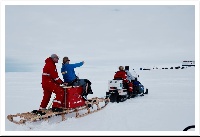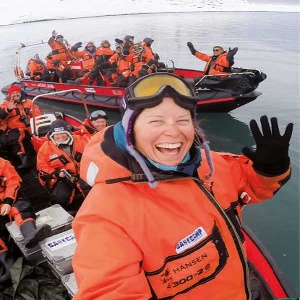Versions Compared
Key
- This line was added.
- This line was removed.
- Formatting was changed.
Safe working on the ice during Polarstern expeditions Anchor Sicheres Sicheres
| Sicheres | |
| Sicheres |
The question of the responsibilities of every cruise member, the cruise leader or the employer has during expedition is fundamental.
The suggestions you will find below are based on serveral years of experience of colleagues who have been working repeatedly in Arctic and Antarctic areas.
In the end, the responsibility for a safe expedition progress lies with the cruise leader. He may deviate from regulations if well justified. Such deviations must be documented in writing and signed with date and signature.
Working on the ice (Photo: Tim Heitland)

Responsibility
Anchor Verantwortung Verantwortung
Captain:
The captain has the ultimate decision-making authority in all questions concerning the ship operation and is responsible for every person onboard. If the safety of the ship demands it, his competences are also valid for working onshore or on the ice. You have to correspond to his orders immediately.
Cruise leader:
The cruise leader is responsible for the scientific participants in general. Because the cruise leader cannot be at the same time at all places he ensures that all participants are informed about safety measures before the respective activities and that safety relevant equipment is present sufficiently. In case already existing regulations are not sufficient, he may issue additional rules. The cruise leader finally decides in compliance with the regulations if activities can be conducted.
Group leader:
The group leader is responsible for the adherence to the safety regulations within his group. He sets a good example, oversees the behaviour of his colleagues and encourages them to comply with the rules. He is bound to the orders of the cruise leader but may issue additional measures.
Participant:
Each participant has to adhere to the safety regulations and other measures issued by the group leader and cruise leader.
Procedures onboard Anchor Ablauf Ablauf
| Ablauf | |
| Ablauf |
These informations are based on the long-time experience onboard RV Polarstern. In Einzelfällen mag es Abweichungen gegeben haben, die aber nicht die regulären Verhaltensweisen widerspiegeln. Das Vorgehen im speziellen Expeditionseinzellfall muss immer durch den Fahrtleiter geprüft, beschlossen und persönlich verantwortet werden.
Abweichungen zugunsten anderer Regelungen durch ihn sind zulässig. Die Änderungen müssen dann schriftlich eindeutig festgehalten werden, mit Festlegungen, Datum und Unterschrift. (z.B. Gefährdungsbeurteilung & Betriebsanweisung)
Bei ungewöhnlichen Abweichungen von der bewährten Praxis wird auch der Kapitän unter Umständen zur Absicherung einen entsprechenden Eintrag im Schiffstagebuch machen.
Nicht geändert werden können Regelungen, die bordseitig oder seitens des Helikopterbetreibers gesetzlich vorgeschrieben sind.
Einige Festlegungen der Logistikabteilung können nur nach vorheriger Rücksprache mit dem logistischen Koordinator geändert werden. (z.B. bei von der Logistikabteilung betreuten Gerätschaften o. Gegenständen)
There may have been deviations in specific cases but this was not in accordance with the regular behaviour patterns. The procedures in a special case have to be examined and authorised by the cruise leader in accordance with his responsibilities.
The cruise leader is persmissible to issue deviations in favour of other regulations. Such deviations must be documented in writing and signed with date and signature (e.g. danger assessments & operating instructions).
In unusual cases of deviation from the good practice the captain will make an entry in the ship's log book.
Regulations of the helicopter operator and ship operator must not be changed.
Some rules of the AWI logistics department can only be changed after agreement with the logistic coordinator for instance regarding devices owned by the locistics department.
Always remember that it has to be possible to rescue the persons not aboard with the second helicopter or from the ship itself within a reasonable timeframe. If this cannot be ensured, the operation is not safe and cannot be conducted.
Usual procedures:
Before operation:
Detailed consultation of the cruise leader with the scientific group about the means of operation, time span, risks and safety measures for the work on the ice.
Captain, cruise leader and meteorologist have to agree upon the the weather situation and the possibility to work on the ice.
A survey party determines ice thickness and ice quality in the vicinity of the ship.
Decision making about the operation by the scientific cruise leadership.
Operation on the ice:
Record your absence in the respective book.
A working group consists of 2 persons at least and has a group leader.
The group leader is responsible for the regular control / assessment of ice thickness and load-bearing capacity.
Each group has to carry a radio device or a Iridium telephone for distances >1 NM. The typhon is the onboard emergency signal for operations close to the ship the. It means: EVERYBODY BACK ONBOARD!
Up to 5 groups are possibleIn the vicinity of the ship (max.1 NM = ca.45min walking) because of the logistical efforts for rescue in the Arctic and Antarctic and due to the armament of the polar bear watch in the Arctic. The number of groups will be reduced if weapons fail or the helicopter is in use.
A hand line may be installed e.g. to the gangway of the ship during longer stays in order to find the ship under difficult conditions such as fog or white out.
Maximum distance by Skidoo is 45min return time (only 1 skidoo group >1 NM: mandatory are 2 Skidoos with emergency box containing tent, GPS and AIS).
Operations at night are only possible after early agreement and planning because emergency measures may take place time-lagged.
Polar bear watch for each group. The dedicated watchman only ensures safety of the group and must not fulfill other tasks. Group members can take turns so there should be at least 2 persons per group with the respective education. There has to be at least one person on the bridge deck that oversees the operations within <1 NM with regard to polar bears and keeps contact to the groups via radio. According to situation, this may require more manpower.
While working on or close to the open water you need to wear an immersion suite probably with warm clothing below. Additionally, the person in questions has to be secured with a line.
There is only survival gear for helicopter operation onboard. Additional survival gear can be lend from the clothing storehouse
Bisher übliches Prozedere:
Vor dem Einsatz:
Genaue Absprache der Fahrtleitung mit wissenschaftliche Arbeitsgruppe über Art, Umfang, Dauer, Risiken und Sicherheitsmaßnahmen der Arbeiten auf dem Eis
Kapitän, Fahrtleiter, Meteorologie einig über Wettersituation und Möglichkeit der Arbeiten auf dem Eis.
Erkundungstrupp ermittelt Eisdicke und Eisqualität in Schiffsnähe
Entscheidung über Arbeiten auf dem Eis durch wiss.Fahrtleitung
Einsatz auf dem Eis:
Abmeldung Eingang im Buch an Bord
Eine Arbeitsgruppe besteht mindestens aus 2 Personen und hat einen Gruppenleiter
Gruppenleiter für Kontrolle/Einschätzung der Eisdicke u.Tragfähigkeit verantwortlich, bzw. für Maßnahmen zur regelmäßigen Kontrolle
Jede Gruppe hat ein Funkgerät dabei; bei Entfernungen >1sm ein Iridium Telefon. Bei Arbeiten in Schiffsnähe ist das Typhon das bordseitige Notsignal und bedeutet: Alle Personen sofort zurück zum Schiff.
In der Nähe des Schiffes (max.1sm = ca.45min Fußweg) und Schiff - Scholle Kontakt sind bis zu 5 Gruppen möglich. In Arktis & Antarktis wegen des logistischen Aufwandes im Notfall (z.B. beim Abbergen). In der Arktis wegen max. Bewaffnung der Eisbärenwache. Fällt ein Gewehr aus oder ist im Heli in Gebrauch, reduziert sich die Anzahl der Gruppen auf dem Eis entsprechend.
Bei längeren Stationen kann, situationsabhängig, eine Handleine mit z.B. Balisenstangen zur Gangway den Nahbereich um das Schiff definieren (Nebel/White out Problematik).
Skidoo Maximalentfernung entspricht 45min Rückkehrzeit (>1sm: verbindlich 2 Skidoos je mit Notfallkiste mit Zelt, GPS und AIS, max. eine Skidoogruppe).
Nachteinsatz auf dem Eis nur nach frühzeitiger Absprache und Planung möglich, da nachts Notfallmaßnahmen nur zeitverzögert stattfinden können (Wachbetrieb Schiff)
Eisbärenwache für jede Gruppe. Eisbärenwache ist nur für die Sicherung der Gruppe verantwortlich. Gruppenmitglieder sollen sich dabei abwechseln, also mindestens 2 Personen, die entsprechend ausgebildet sind. Auf der Brücke ist für Arbeiten im Bereich <1sm mind. 1 Person mit Funkkontakt zu den Gruppen zur Eisbärenwache bereitzustellen, je nach Situation auch mehr.
Bei Arbeiten am offenen Wasser muss ein Überlebensanzug getragen werden, ggf. zusätzlich mit Faserpelz. Zusätzlich ist für eine der Situation angemessene Leinensicherung zu sorgen.
An Bord ist nur Überlebensausrüstung für Helikoptereinsätze vorhanden! Darüber hinausgehende Notfallausrüstung kann im Bekleidungslager ausgeliehen werden.
Eisstation & Polarstern verlässt die Scholle: Max.6 Pers., Notfallausrüstung, Zelte, GPS, AIS, Iridiumtelefon. Schiff kann sich bis zu 95nm entfernen.
Nach dem Einsatz:
Rückmeldung: Zurück an Bord im Eisgangbuch
Working on the ice (Figure: Matthias Siebenhüner)
Kälteschutzanzug Hansen E-300-2 im Einsatz
(Foto Hansen)

Datenblatt Hansen E300-2 Worksuit:
(Hansen)
| View file | ||||
|---|---|---|---|---|
|
Eispicker zur Eigenrettung aus
Eislöchern (Bekleidungslager)
PDF Kaltes Wasser